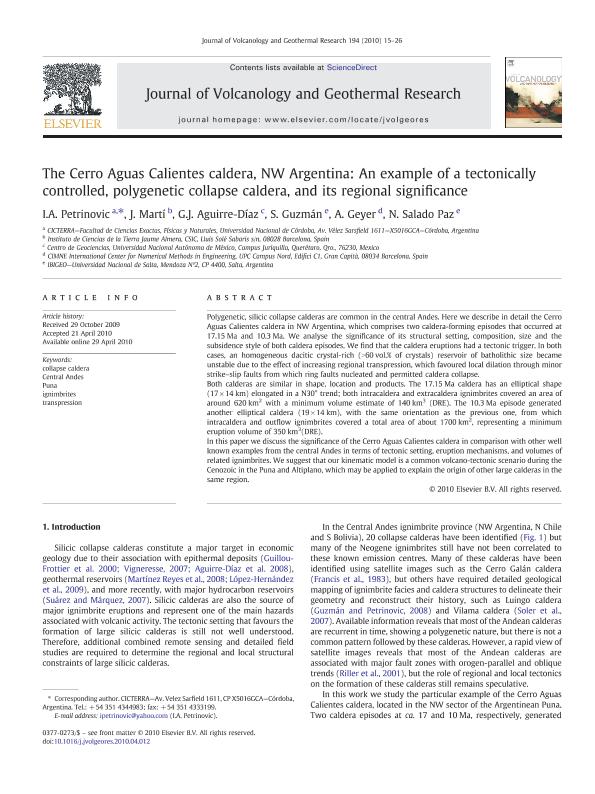Artículo
The Cerro Aguas Calientes caldera, NW Argentina: An example of a tectonically controlled, polygenetic collapse caldera, and its regional significance
Petrinovic, Ivan Alejandro ; Martí, J.; Aguirre Díaz, G. J.; Guzman, Silvina Raquel
; Martí, J.; Aguirre Díaz, G. J.; Guzman, Silvina Raquel ; Geyer, A.; Salado Paz, Natalia
; Geyer, A.; Salado Paz, Natalia
 ; Martí, J.; Aguirre Díaz, G. J.; Guzman, Silvina Raquel
; Martí, J.; Aguirre Díaz, G. J.; Guzman, Silvina Raquel ; Geyer, A.; Salado Paz, Natalia
; Geyer, A.; Salado Paz, Natalia
Fecha de publicación:
07/2010
Editorial:
Elsevier Science
Revista:
Journal of Volcanology and Geothermal Research
ISSN:
0377-0273
Idioma:
Inglés
Tipo de recurso:
Artículo publicado
Clasificación temática:
Resumen
Polygenetic, silicic collapse calderas are common in the central Andes. Here we describe in detail the Cerro Aguas Calientes caldera in NW Argentina, which comprises two caldera-forming episodes that occurred at 17.15. Ma and 10.3. Ma. We analyse the significance of its structural setting, composition, size and the subsidence style of both caldera episodes. We find that the caldera eruptions had a tectonic trigger. In both cases, an homogeneous dacitic crystal-rich (>60. vol.% of crystals) reservoir of batholithic size became unstable due to the effect of increasing regional transpression, which favoured local dilation through minor strike-slip faults from which ring faults nucleated and permitted caldera collapse.Both calderas are similar in shape, location and products. The 17.15Ma caldera has an elliptical shape (17×14km) elongated in a N30° trend; both intracaldera and extracaldera ignimbrites covered an area of around 620km2 with a minimum volume estimate of 140km3 (DRE). The 10.3Ma episode generated another elliptical caldera (19×14km), with the same orientation as the previous one, from which intracaldera and outflow ignimbrites covered a total area of about 1700km2, representing a minimum eruption volume of 350km3(DRE).In this paper we discuss the significance of the Cerro Aguas Calientes caldera in comparison with other well known examples from the central Andes in terms of tectonic setting, eruption mechanisms, and volumes of related ignimbrites. We suggest that our kinematic model is a common volcano-tectonic scenario during the Cenozoic in the Puna and Altiplano, which may be applied to explain the origin of other large calderas in the same region. © 2010 Elsevier B.V.
Palabras clave:
Central Andes
,
Collapse Caldera
,
Ignimbrites
,
Puna
,
Transpression
Archivos asociados
Licencia
Identificadores
Colecciones
Articulos(IBIGEO)
Articulos de INST.DE BIO Y GEOCIENCIAS DEL NOA
Articulos de INST.DE BIO Y GEOCIENCIAS DEL NOA
Citación
Petrinovic, Ivan Alejandro; Martí, J.; Aguirre Díaz, G. J.; Guzman, Silvina Raquel; Geyer, A.; et al.; The Cerro Aguas Calientes caldera, NW Argentina: An example of a tectonically controlled, polygenetic collapse caldera, and its regional significance; Elsevier Science; Journal of Volcanology and Geothermal Research; 194; 1-3; 7-2010; 15-26
Compartir
Altmétricas



